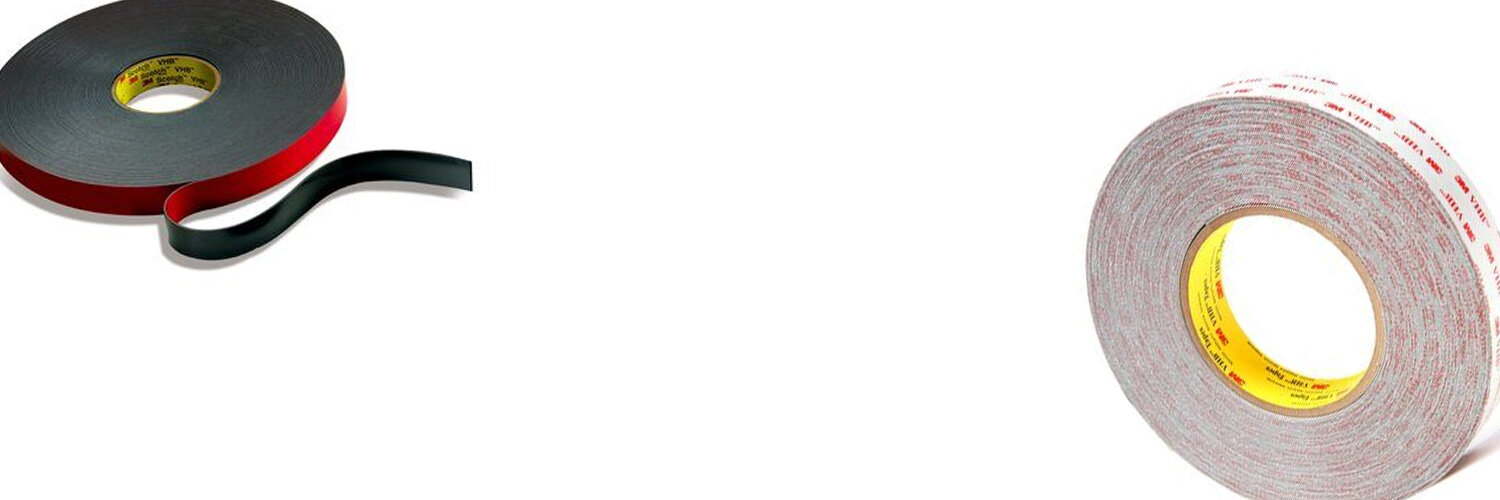VHB Tape Guide: Is My Application Right for Acrylic Foam Tape?
Acrylic foam tapes are exceptionally high-strength pressure sensitive adhesive (PSA) tapes that are meant to be used as permanent bonding solutions in a wide range of applications. Widely known by the brand 3M™ VHB™ tapes or sometimes simply hi-bond tapes, these double-sided acrylic foam tapes were invented and commercialized by 3M™ in 1980. The tape remains an important category where 3M is still innovating the technology today.
Over 40 years have passed since their introduction and 3M has developed a wide range of VHB tape families which are developed for specific applications and substrates. Also, since introduction, many competitive entrants have developed acrylic foam tape offerings to compete with 3M VHB. Some from lessor known tape companies have suffered from quality issues, while those from larger global tape providers like St. Gobain and Tesa are quite competitive. However, 3M remains today the most trusted, most knowledgeable, most innovative provider of acrylic foam tape.
Different 3M™ VHB™ tapes are ideal for different applications, depending on the substrates being bonded and the performance environment. While they are not designed for every application, the wide selection of VHB tape options make them ideal for many applications.
Should you be using VHB tape in your application? We can help you make the right choice.
What is VHB Tape?
VHB tapes have an acrylic foam core with an acrylic pressure sensitive adhesive applied. The tape is naturally viscoelastic, allowing it to maintain a high level of strength and elasticity as it's exposed to different forces, stressors, and environmental elements. The tape is generally used for high performance, non-structural bonding—more on the benefits of using the tape and specific applications below.
VHB tapes are best known as a permanent bonding solution because the bond builds up strength over time, achieving 90% strength in as little as 72 hours and continuing to hold that bond almost indefinitely. Because the foam tape core and the PSA are both made from acrylic, the bonding material offers high heat, chemical, and environmental resistance, and can be used in both indoor and outdoor applications.
With a wide range of product families for nearly any application, VHB tape can be the ideal bonding solution for many companies.
Why Use VHB Tapes?
VHB tapes have grown to become a leading bonding solution because of the many benefits it has over other attachment methods. VHB tapes are often used to replace rivets, spot welds, mechanical fasteners, and liquid adhesives. When used in place of these more traditional bonding solutions, VHB tapes offer many benefits, including:
Simple application: they require no special tools or skills to apply, and less-skilled labor can be used than required for complex metalwork.
Quicker application and cleanup: they streamline assembly, saving labor and time
Invisible fastening: VHB tapes create a seamless bond where no screws, rivets, etc., are present, nor is there any liquid adhesive residue leftover. This allows for better design and aesthetics.
Consistent bond-lines: VHB tapes allow for even application of the adhesive. This reduces weak points in the bond and allows for thinner materials and cleaner bond-lines.
Bonding dissimilar materials: double-sided VHB tapes can bond different types of substrates. This is particularly useful in preventing galvanic reactions between different types of metals.
Noise and vibration reduction: VHB foam tapes bond and help absorb noises and vibrations.
VHB tapes also have high resistances to:
Shock and impact
Dynamic loads
UV light
Humidity, high and low temperatures, and thermal cycling
Water and moisture, and various chemicals
VHB Tape Applications: The Right Fit
Very high bonding tapes can be used to join materials ranging from aluminum and steel to glass, plastics, and even painted and powder-coated surfaces. Different tapes have varied levels of adhesion to different types of materials, making them ideal for applications in industries that include:
Electronics (phones, cameras, TV, etc.)
Construction (glass panes, curtain walls, and window muntin bars, gaskets and seals, etc.)
Transportation (trim mounting, sidewall panels, stiffeners, etc.)
Appliances (nameplates and logos, oven cladding, displays, etc.)
Signage (mounting, trim, panel to frame bonding)
When should you use VHB tapes? They work best in:
Permanent bonds that experience significant dynamic loads
Non-structural applications
Bonding applications of lighter gauge metals and plastics
Applications with weather extremes or temperature cycling
Applications with service times of decades
Applications like bonding panels to frames, stiffeners to panels, decorative trim to panels, etc.
While VHB tapes are ideal for a wide range of applications, it’s best to avoid using them in certain scenarios. VHB tapes are not ideal for:
Bonding heavy and unsupported dead loads
Bonding dead loads with a small bonding area that leave very little area for tape application
Joint attachment or structural applications (e.g., connecting framework)
Applications with long term fuel emersion
Applications with long-term exposure to elevated temperatures (> 200° F)
Applications where part attachment takes place in temperatures <50° F
Explore Some of Our 3M VHB Tape Options

